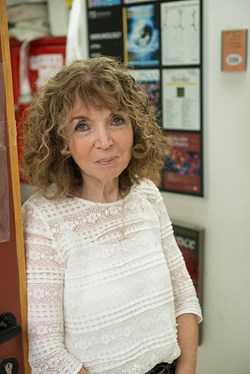
For many years, scientists believed that the brain was completely isolated from the immune system because of a shield called the blood-brain barrier.
That dogma has changed, due in no small part to the research of Prof. Michal Schwartz of the Weizmann Institute of Science’s Department of Neurobiology.
“My assumption was always that the immune system does help repair the brain, but that it has a very unique way of communicating across the blood-brain barrier,” she says. “This assumption turned out to be correct. However, the work that it took to get there was very difficult.”
In a series of studies that began about 20 years ago, Prof. Schwartz and her research group proved that the immune system plays an important role both in healing the central nervous system after injury and in maintaining the brain’s normal functioning. In the late 1990s, she published scientific papers that demonstrated, for the first time, that two types of immune cells – macrophages and T cells – are involved in repairing the central nervous system.
Prof. Schwartz and her team also found that the interaction between the brain and the immune cells present in the blood occurs across a unique interface called the choroid plexus. The choroid plexus is found in each of the brain’s four ventricles, and separates the blood from the cerebrospinal fluid. On one side it is exposed to signals from the brain and on the other side to those from the circulatory system.
Prof. Schwartz’s research overturned the dogma that the brain and immune system are isolated from each other. In fact, she showed that the immune system actually helps repair the brain.
“The choroid plexus orchestrates the way by which the immune system helps the brain,” Prof. Schwartz explains. When the brain releases biochemical “danger” signals following acute injury or neurodegenerative damage, the immune cells in the blood sense those signals through the choroid plexus. The immune cells on the other side of this interface then activate it, turning it into a gateway that facilitates entry of immune cells to the diseased brain; they can then help its repair.
Prof. Schwartz’s studies also show that the choroid plexus plays a role in aging. “We found that aging of the brain and the development of Alzheimer’s disease is associated with the aging of this interface. It doesn’t function anymore,” she notes.
A major focus of her current work is the development of novel approaches for harnessing the immune system to treat Alzheimer’s and other neurological disorders.
“When we went to the literature, we learned that certain immunotherapy drugs currently used to treat cancer – known as PD-1 pathway, or “checkpoint,” inhibitors – neutralize the suppression of the immune system,” says Prof. Schwartz. By blocking the PD-1 pathway – the T cells’ “off switches” – the immunotherapy drugs mobilize the immune system to destroy cancer cells. These checkpoint inhibitor drugs are used to treat melanoma, non-small-cell lung cancer, and bladder cancer, among other malignancies.
“Our vision is to help the body use its own sophisticated system of repair,” says Prof. Schwartz.
In research published in Nature Medicine in 2016 and Nature Communications in 2019, Prof. Schwartz and her colleagues demonstrated that blocking the PD-1/PD-L1 pathway in T cells allowed increased levels of immune macrophage cells in the brains of mouse models of Alzheimer’s and dementia. Not only did this improve the performance of the mice on memory tasks, it also reduced the accumulation of the misfolded proteins that are characteristic of Alzheimer’s. The approach is currently in development.

In addition, Prof. Schwartz and her team, collaborating with immunogenomics expert Prof. Ido Amit of Weizmann’s Department of Immunology and his research group, are developing a next-generation approach for Alzheimer’s that involves boosting targeted immune cells within the brain.
She and her team are developing a treatment for Alzheimer’s disease that is based on boosting targeted immune cells in the brain.
Prof. Schwartz received her PhD in chemical immunology from the Weizmann Institute in 1977, coming back to the Institute for good in 1980 after completing postdoctoral studies on nerve regeneration at the University of Michigan. Married to a biophysicist/biochemist, she is the mother of four children and a grandmother. In 2015, Yale University Press published her book Neuroimmunity: A New Science That Will Revolutionize How We Keep Our Brains Healthy and Young. Aimed at general readers, the book recounts her journey as a woman in science and the triumphs and setbacks that led to the discovery of the connections between the immune system and the brain.
Prof. Schwartz hopes to help Alzheimer’s sufferers by bringing her PD-1-blocking technique to market. A startup company founded on the basis of her discoveries has signed a cooperation agreement with Danish pharmaceutical firm Lundbeck.
“The effect we saw in mice is really amazing and I’m hopeful that we’ll see the same effect in humans,” says Prof. Schwartz. “Our vision is to help the body use its own sophisticated system of repair.”
Prof. Michal Schwartz’s research is supported by the Sagol Institute for Longevity Research; the Thompson Family Foundation; the Adelis Foundation; the Rowland & Sylvia Schaefer Family Foundation; and Carla Hunter and Andre M. Schub. She is the incumbent of the Maurice and Ilse Katz Professorial Chair of Neuroimmunology.
